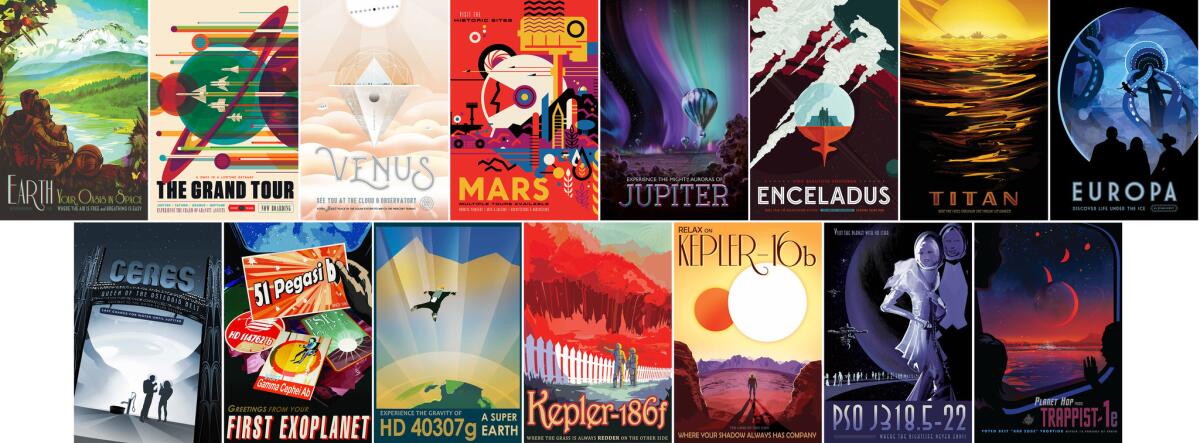Explore 14 alien worlds (and Earth) with NASA’s whimsical travel posters

Explore 14 alien worlds (and Earth) with NASA ’s whimsical travel posters
It’s never too early to plan your trip to space, at least according to the folks at NASA.
To travel to alien worlds, humans would need light-speed technology — or have millions of years to spare to fly by jumbo jet. In the meantime, we can imagine our extraterrestrial dream vacation thanks to a team of designers at NASA’s Jet Propulsion Laboratory.
With a set of 15 downloadable travel posters, we can follow in the footsteps of NASA’s
Found: Seven rocky Earth-sized planets in orbit around a nearby star »
There’s also a poster promoting Earth as a destination, reminding the weary space traveler that there’s no place like our warm, watery, breathable home.
Poster-sized images are available to download for free on JPL’s website.
Earth
We can already explore Earth every day, but it’s nice to have a place we call home in the universe.
‘The Grand Tour’
Follow in the footsteps of the 1977 Voyager mission for a grand tour of the solar system. The twin spacecrafts revealed new details about Jupiter, Saturn, Uranus and Neptune as they used each planet’s gravity to propel them farther into space, called a “gravity assist.”
Venus
Though we’re not sure how pleasant Venus would be to visit, given its toxic atmosphere and lead-melting heat, it would offer a fine view of the Mercury transit, when the small planet appears as a black dot crossing the sun’s face.
Mars
By the time humans land on Mars, we’ll already have a rich history of exploring the Red Planet. This poster takes a nostalgic look at some of NASA’s previous missions to Mars, including rovers, space probes and satellites.
Jupiter
Jupiter’s auroras create the best light show in the solar system, with northern and southern lights that are hundreds of times more powerful than the ones seen on Earth.
Enceladus
Enceladus, Saturn’s tiny moon, helped create the planet’s E-ring with its icy jets. Cassini missions also found evidence of a global ocean and the first signs of hydrothermal activity on another world, putting the moon toward the top of the list of places that might support life beyond Earth.
Titan
Saturn’s largest moon is one of the most planet-like in the solar system. Come for the views of liquid ethane and methane lakes, and stay for the (possible) cryo-volcanoes of cold liquid water.
Europa
Dive underneath Europa’s icy surface and into its ocean of salty liquid water. Who knows what might be living down there? A NASA mission to the Jupiter moon could find out in the 2020s.
Ceres
Ceres is the largest object in the asteroid belt between Mars and Jupiter. With an equatorial diameter of 600 miles, it’s the closest dwarf planet to the sun.
51 Pegasi b
If you’re looking for an extended getaway, consider 51 Pegasi b — a journey of about 50 light-years. Just 4.2 Earth days constitutes a year on the exoplanet.
HD 40307g
For thrill-seekers: Exoplanet HD 40307g has eight times the gravitational pull of Earth. Scientists aren’t sure whether to classify it as a “super-Earth” or “mini-Neptune,” as they aren’t sure whether it has a rocky surface or one buried beneath gas and ice.
Kepler-186f
Kepler-186f could be quite Earthlike: It’s the right size and it orbits within the habitable zone of its star. But the star is much cooler and redder than our sun, meaning Kepler-186f’s plant life would boast a color palette very different from the green on Earth.
Kepler-16b
You could be like Luke Skywalker on Kepler-16b and gaze off toward its two setting suns, just like the planet Tatooine in the “Star Wars” films. Travelers beware: The exoplanet also could be a gas giant like Saturn instead of having the rocky surface seen here.
PSO J318.5-22
The rogue planet PSO J318.5-22 wanders alone in the galaxy, free from the orbit of a parent star. So it’s always night and the party never ends.
Trappist-1
The fourth planet from an dim red star, TRAPPIST-1e, could be covered in liquid water and is in perpetual twilight. With its nearby sister planets lighting up the sky, a new adventure is just a planet hop away.
MORE IN SCIENCE
Can a mouse meditate? Why these researchers want to find out
NASA's Juno spacecraft to remain in extra-long orbit for the rest of its time at Jupiter
'Extraordinary levels' of pollution have contaminated even the deepest parts of the Pacific Ocean




